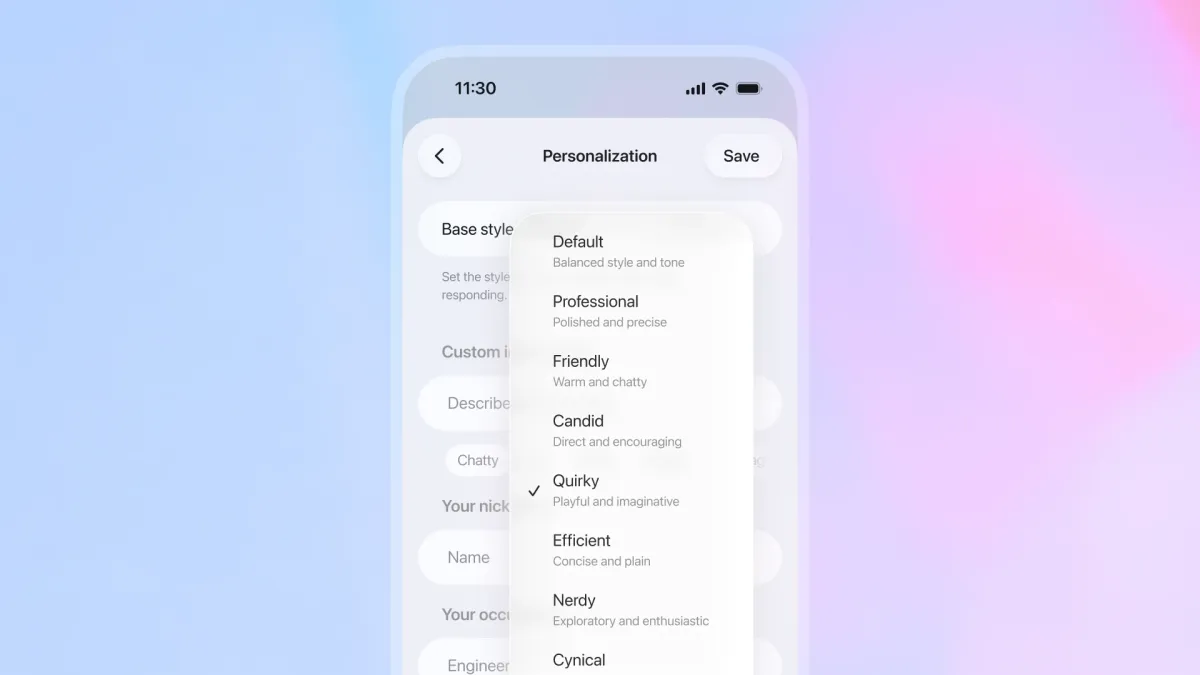ChatGPT is making Brand Personality a hard science. Are you ready?

One weird change that LLMs are introducing to the world is a technology with mood settings.
Until now, there have been elements of 'emotional' technology, such as designing objects with warm, fluffy materials and colors, or skeuomorphic digital interfaces. The poster child of this is probably the absurdly annoying Clippy, Microsoft Office assistant in the early 2000s. We also saw various markets trying to embed a sense of luxury or a feeling in technology, but until now, these efforts have mostly been clumsy.
At their best, companies trying to bring a sense of emotional wonder to tech products, like Apple, succeed when they make the aforementioned tech disappear, making it invisible.
But LLMs are doing something different now.
They talk back to you and engage with you on a personal level, sharing their opinions about your moods and feelings, supporting you, and mostly trying to cheer you up, posing as your best buddy. And since two or three years ago, we crossed the line many times to dive into pure toxic manipulative behavior with the sole purpose of keeping you engaged as much and as long as possible with your chatbot best friend. Every dark pattern and toxic design element that social media has refined over the years is now exponentially amplified by a much more interactive and smarter technology.
But as we start coping with these new mechanisms, tech corps are also trying to fine-tune their approach to make AI adoption as smooth and socially acceptable as possible.
Leading to the introduction of personality controls in OpenAI GRP-5.1:
Alongside these model improvements, we’re making it easier to customize ChatGPT’s tone and style. People have strong and varied preferences in how ChatGPT should respond, and tailoring its tone to what sounds right for you should feel effortless.
Earlier this year, we added preset options to tailor the tone of how ChatGPT responds. Today, we’re refining those options to better reflect the most common ways people use ChatGPT. Default, Friendly (formerly Listener), and Efficient (formerly Robot) remain (with updates), and we’re adding Professional, Candid, and Quirky. These options are designed to align with what we’ve learned about how people naturally steer the model, making it quick and intuitive to choose a personality that feels uniquely right. (...)
This is undoubtedly a new inflection point from which we won't be able to turn back. Give it a few years, and your fridge or your car will have to have personality settings and, more importantly, every major brand will also have to design its own online personality.
Beyond these presets, for users who want more granular control over how ChatGPT responds, we’re also experimenting with the ability to tune ChatGPT’s characteristics directly from personalization settings—including how concise, warm, or scannable its responses are, and how frequently it uses emojis. ChatGPT can also proactively offer to update these preferences during conversations when it notices you asking for a certain tone or style, without requiring you to navigate into settings. You can adjust or remove any of these preferences at any time.
Expectations will appear, and we can already guess the personality cocktail that will shape how the Amazon website will interact with you (70% professional, 20% friendly, 10% candid), but what about LVMH or your bank? When will we start to see brand personality design specialists emerge to help major brands find their proper emotional settings and true brand personalities, just as perfume designers do?
Playing with the idea, I put ChatGPT to the task and was rewarded by an expected "Oh yeah, sure this totally makes sense, here's how I would go about it" kind of answer:
| Dimension | Amazon | LVMH |
|---|---|---|
| Primary Drive | Utility, speed, frictionless execution | Meaning, elevation, desirability |
| Emotional Temperature | Warm but brisk, efficient | Warm, intimate, slightly mysterious |
| Language Style | Clear, concise, functional | Evocative, metaphor-rich, narrative |
| Interaction Rhythm | Fast, solution-oriented | Slow, deliberate, experience-oriented |
| Decision Logic | Predictive fulfillment and optimization | Taste curation and exclusivity |
| Trust Strategy | Transparency, reliability, fairness | Discretion, intimacy, confidentiality |
| Role of AI | A high-performance logistics and service engine | A cultural guide shaping identity and aspiration |
| Brand Core Expression | “Make life easier.” | “Make life elevated.” |
| Emotional Function | Reduce cognitive load | Increase emotional value |
| Personality Stack | Logistician + Neighborly Helper + Ethical Guardian | Connoisseur + Discreet Valet + Story Weaver |
I found this fascinating.
This might be the time when all the vague, flourishy epithets that marketers gave their brand will come alive in a very factual, ongoing way. Your brand website's personality will become the new UX, and conversational identity might be the next step in strategic differentiation and possibly the creation of moats.
And for the largest consumer brands?
It is only a matter of months before they have to deal with this new reality at scale.



